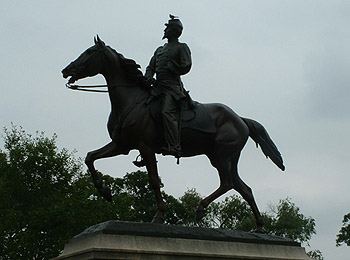Statues That Do not Follow the Rule
GEN. SIMON BOLIVAR: 18th at C and Virginia NW (1959). One hoof raised; died in peace of tuberculosis.
MAJ. GEN. NATHANIEL GREENE: Stanton Square, Maryland and Massachusetts NE (1877). One hoof raised; died in peace, unwounded.
MAJ. GEN. ANDREW JACKSON: Lafayette Park (1853). Two hooves raised; died in peace.
LT. GEN. THOMAS J. (STONEWALL) JACKSON: Manassas (1940). All hooves on ground; wounded by own men and died.
MAJ. GEN. PHILIP KEARNY: Arlington National Cemetery (1914). One hoof raised; died in battle.
MAJ. GEN. GEORGE B. McCLELLAN: Connecticut Avenue and Columbia Road NW (1907). One hoof raised; died in peace, unwounded.
BRIG. GEN. JAMES B. McPHERSON: McPherson Square, 15th between K and I streets NW (1876). One hoof raised; shot and killed in battle.
BRIG. GEN. COUNT CASIMIR PULASKI: 13th and Pennsylvania NW (1910). One hoof raised; died in battle.
LT. GEN. GEORGE WASHINGTON: Washington Circle, at 23rd and K and Pennsylvania and New Hampshire NW (1860). One hoof raised; died in peace of cynache trachealis. Washington Cathedral (1959). One hoof raised.
Given that the alleged statuary code consists of three poses (no hooves raised, one hoof raised, and two hooves raised), the odds that a rider's manner of death would correspond to his horse's pose through plain chance are one in three, which is the proportion we find when surveying the equestrian statues in America's capital — that is, only about ten out of thirty statues in Washington, D.C., follow the "traditional" pattern.
The connection between statuary horses hooves' and the manner of deaths of their riders is not "tradition," but — like the well-known but mundane list of "coincidences" between the Lincoln and Kennedy assassinations — an attempt to create an interesting piece of information (in this case, something akin to a "secret code") by finding patterns in randomness through the expedient of simply ignoring or explaining away all the cases that don't fit the pattern.
Once again, proof that folklore never dies — it simply gets updated in time and place to keep it relevant to modern audiences



0 Comments:
Post a Comment
Subscribe to Post Comments [Atom]
<< Home